Diversity and Inclusion: A Pharma 50 Perspective
Pharmaceutical Executive
Biopharma’s diversity commitment remains a work in progress but the benefits-in measurable ROI-are increasingly clear.
Organizations across all industries have begun to recognize that diversity efforts go well beyond simple anti-discriminatory compliance and image campaigns; they provide clear business benefits. Company leaders are creating programs to increase diversity from their board levels all the way down the ranks of the organization.
Underlining these efforts, McKinsey & Company’s pivotal paper, “Diversity Matters,” published in 2014, looked at the relationship between the level of diversity, defined as “a greater share of women and a more mixed ethnic/racial composition in the leadership of large companies,” and company financial performance, measured as average earnings before interest and taxes (EBIT), for the years 2010 to 2013.
The analysis found a statistically significant relationship between leadership diversity and financial performance. More specifically, the companies in the top quartile for gender diversity were 15% more likely to have above-average financial returns, while the companies in the top quartile for racial/ethnic diversity were 30% more likely to have above-average returns.
Although it proves a correlation and not causation, the paper argues that “more diverse companies are better able to win top talent and improve their customer orientation, employee satisfaction, and decision making, leading to a virtuous cycle of increasing returns.”
Given these findings, we would expect to see the pharma industry diversifying across the globe. And it seems that a handful of Pharma 50 companies are indeed helping lead the way in diversity efforts. A US-based organization called DiversityInc conducts a voluntary survey of company diversity each year and then ranks the companies on four key areas of diversity management: talent pipeline, equitable talent development, CEO/leadership commitment, and supplier diversity. Individual company data is kept anonymous.
In 2016, more than 1,800 organizations participated in the survey, which is now in its 17th year. Significantly, six of this year’s Pharm Exec 50 companies are listed: Novartis Pharmaceuticals Inc. (#2), Johnson & Johnson (#8), Abbott Labs (#14), Merck & Co. (#17), Eli Lilly (#26), and AbbVie (#45).
Yet a closer look at the pharma industry shows that, while diversity continues to improve, the Pharma 50, as a group, is right in the middle of the industry pack when benchmarked against the Fortune 500. In addition, we find striking differences in the levels of gender, national, and ethnic diversity when we look at the boards and executive committees of individual companies Some are true diversity champions, while others lag far behind. And this disparity persists across regions.
Of course, the definition of diversity differs across geographies. In the US, for example, diversity tends to be defined by gender and ethnicity. In Europe, by contrast, the diversity discussion revolves around gender and nationality. In the workforce in all regions, however, the diversity debate not only relates to demographic criteria such as gender, nationality, ethnicity, and age, but encompasses sexual orientation and the broad experiences, personality types, and work styles of company employees.
A step further: Russell Reynolds’ proprietary research
Using a bottom-up approach, Russell Reynolds Associates (RRA) conducted a proprietary analysis of thePharm Exec Pharma 50 to find out more about diversity on two important organizational levels: the board level, including non-executive and executive board directors, but excluding employee representatives; and the executive committee (ExCo) level, including CEOs and their direct reports.
The research was conducted using publicly available information from April 2016, such as BoardEx, LinkedIn, and company websites, and contains data points for over 1,000 individuals.
For the purposes of this analysis, we categorized the Pharma 50 companies into five broad types: big Pharma companies based in the US; big Pharma companies based in the European Union (EU); specialty pharma companies; pharma companies outside of the US and EU; and privately held pharma companies, primarily in the EU. Our categorization is described in Figure 1 below.
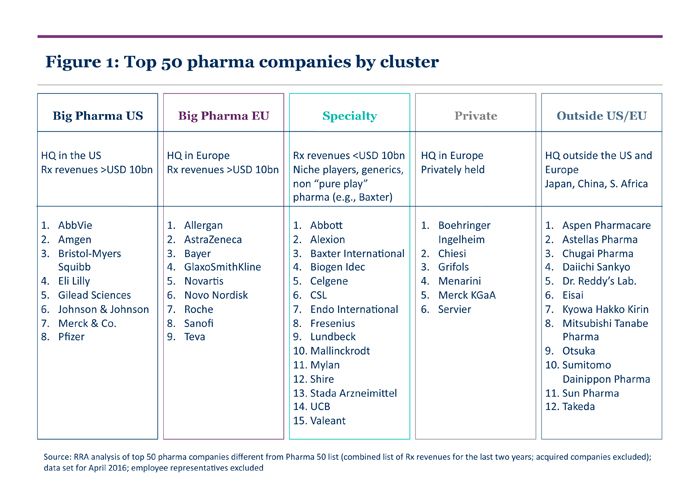
Our main objective was to investigate the pharma industry’s commitment to diversity, as reflected by the diversity of the boards and ExCos of the companies we analyzed, both relative to other industries and within the industry.
We used publicly available distinctions of gender, ethnicity, and nationality to investigate board and committee composition. Within nationality, we typed individuals as being either “national” or “foreign” to the organization’s headquarters location.
For example, a UK national sitting on the board of a US company would be considered “foreign”; however, a UK individual on the board of a French company would be considered “national,” as we have categorized the EU as a single country cluster.
At the outset, we established three hypotheses we wanted to investigate:
- Hypothesis 1: Given the dynamic nature of the life sciences industry and the global breadth of its customers, pharma would be ahead of other industries in terms of board diversity.
- Hypothesis 2: Given the globalization of the patient base and of pharma operations, the members of the ExCos of pharma organizations would be more diverse than the boards.
- Hypothesis 3: Given their entrepreneurial and innovation framework, smaller specialty pharma companies would be more diverse than big Pharma companies.
âAre pharma boards ahead?
For the first hypothesis, we looked at diversity at the board level for pharma companies and compared it to the diversity of boards in other major industries. As noted earlier, we presumed that the pharma industry would be ahead of many of the other industries in diversity.
For the comparator industries, RRA took 453 publicly traded companies in the Fortune 500 and categorized them into industry sectors. We then analyzed the composition of the board for each of these companies as of July 2015, when the Fortune 500 lists were announced. For each of the industries, we calculated four factors:
- The average number of directors on the board of each company (“average board size”)
- The share of board seats held by women (“% of board seats held by females”)
- The share of board seats held by ethnically diverse directors (“% board seats held by ethnically diverse directors”)
- The share of board seats held by individuals who have a nationality different from the headquarters of the country (“% diverse board seats in terms of nationality”)
The results are found in Figure 2 below. While we hypothesized that the pharma industry, as represented by Pharma 50 companies, would have strong diversity compared to the other industries, we found-to our surprise-that it generally has less gender and ethnic diversity than the other industries in the Fortune 500.
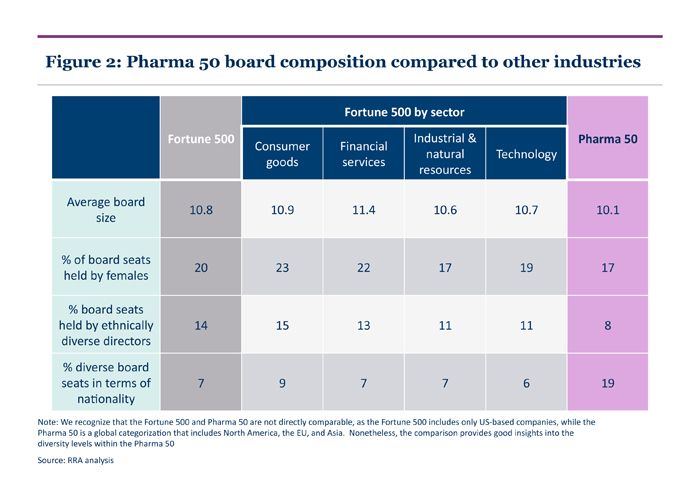
The average board size within the Pharma 50 does not differ significantly from the board size within the Fortune 500, even when broken out by industry. Yet when we look at gender diversity, the Pharma 50 has a share of female board seats that is well behind that of companies in the other industries in the Fortune 500, with the exception only of the industrial and natural resource industry (with about the same share).
We even found that 16 of the Pharma 50 companies (about one-third) have no women on their boards at all. And while this is true primarily in companies outside of the US and EU, it occurs in all five identified clusters.
In addition, the Pharma 50 lag behind companies in all the other industries in terms of seats held by ethnically diverse directors. Whereas the share of seats held by ethnically diverse directors for the Fortune 500 overall is about 14%, for Pharma 50 the share is around 8%.
In contrast, the international diversity of board seats seems to be stronger in the Pharma 50 companies than in the other companies in the Fortune 500, by a significant degree. We will look further into this variation as we look at the other hypotheses.
Are ExCos more diverse?
For the second hypothesis, we looked within the Pharma 50 companies to examine the diversity of their boards compared to the diversity of their executive committees. We predicted that the make-up of the individuals in the most senior management positions would be more diverse than that of the boards of the same companies. We once again looked at three dimensions of diversity: gender, ethnicity, and nationality.
For gender diversity, we found that the ExCos of these companies have even lower female representation. About 12 % of ExCo seats are held by women and 19 of the 50 companies have no women on the ExCo at all. In a surprising finding, therefore, the management teams are generally less gender-diverse than the boards, and this holds true across each of the clusters (see Figure 3 below).
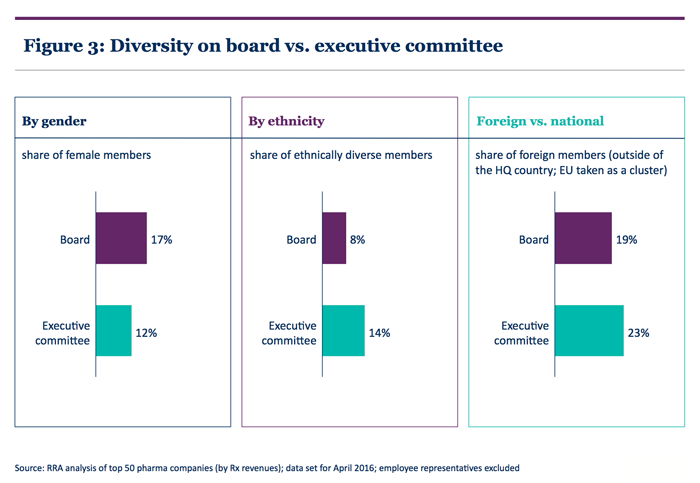
On the nationality dimension, we find that boards and ExCos within the Pharma 50 are almost equally diverse, with numerous nationalities represented. Executive teams have an average of 3.2 different nationalities among the members, while boards have an average 2.6. This strong national diversity may be a reflection of the global nature of the business, which we noted in our hypothesis 1.
In addition, it may be only natural that the Pharma 50 has greater diversity by nationality than the Fortune 500, given it includes the EU, where almost all big Pharma companies have at least one American on the board.
Specialty pharma in the lead?
For the final hypothesis, we looked to see if there was a variation in diversity among different types of pharma companies. We speculated that specialty pharma companies in the Pharma 50 would be more diverse than big Pharma because of their entrepreneurial nature and innovation based approach to therapies.
Our analysis revealed that, in fact, specialty pharma companies are somewhat diverse in terms of gender at the board and ExCo levels, although not quite as diverse as big Pharma in either Europe or the US (see Figures 4 and 5 below). Yet in terms of ethnicity, we find that specialty companies in general have a lower share of diverse board and ExCo members than big Pharma in the US or EU. This may well be because big Pharma companies receive far more public scrutiny than do specialty pharma companies, putting them under pressure to diversify.
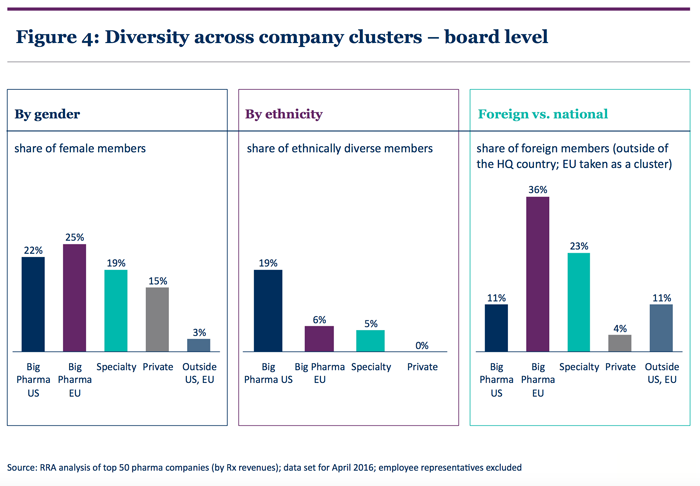
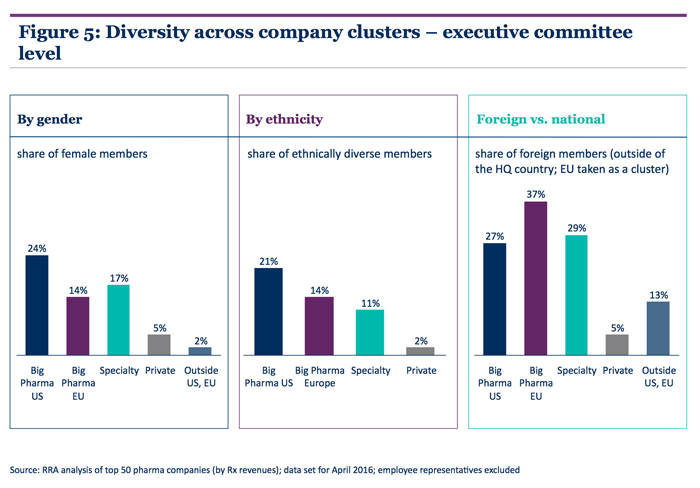
Looking at diversity by nationality, specialty pharma companies do fairly well, with a 23% share of foreign board members and a 29% share of foreign ExCo members, compared to 11% and 27%, respectively, for big Pharma in the US and 36% and 37%, respectively, for big Pharma in the EU. This is particularly interesting given our finding that big Pharma companies in the US and Europe generally have more diversity on their boards and ExCos than other types of pharma companies, while companies headquartered outside the US and EU have the least diversity.
Perhaps more interesting, when we look outside the clusters, we see that 16 and 14 out of the top 50 pharma companies’ boards and ExCos, respectively, have only one nationality represented on their boards-that of the headquarters country.
Inclusion matters
Although we have focused on diversity in the body of this paper, there is a second very important side to the diversity coin: inclusion. Whereas diversity reflects the different types of individuals resident in a company, inclusion is the glue that brings these individuals together.
Inclusion is essential if companies are to integrate diverse talent into their organizations. When diverse talent is unable to integrate effectively into the organization’s culture, there are negative implications for the business, such as increased turnover costs and loss of accumulated knowledge. There is therefore little point in tackling diversity without also solving for inclusion-ensuring that every person is able to participate and realize his or her full potential. Whereas diversity is the hardware bringing different machines together, inclusion is the software that brings the system to life.
Diversity and inclusion should not be standalone HR initiatives, but included in the overall business and talent strategy. Sponsorship and tangible support from the very top-board- and ExCo-level-are required. Companies will also need a structured approach, including a clear diversity-and-inclusion strategy and roadmap to success. Hiring a chief diversity officer can help, accelerating the process at the highest levels.
To ensure true inclusion, the Pharma 50 companies will also need to understand the areas in which they may have unconscious biases, and take bold moves to address those issues. They will need to embrace new ways of thinking, new styles of behavior, and cultural modifications.
Finally, companies will need to move away from the traditional approach of exclusively measuring demographics and toward a new approach that includes engaging with more sophisticated metrics-especially those that measure the inclusiveness of the corporate culture.
Reach for equilibrium
We believe pharma companies have recognized the importance of diversity and are working to increase it. We are confident, for example, that if we were to conduct an analysis of the current general managers in place within the top 50 pharma companies in the leading economies-i.e., the pipeline of next-generation C-level executives-it would reveal an increasing gender diversity. In addition, we believe that other forms of diversity, beyond gender diversity, are growing within these ranks.
This diversity is holding strong here and there on the senior levels. If we look exclusively at board composition over the past 12 years, for example, we see an increase in female representation in top companies, from 13% of the top 10 by sales in 2004, to 24% of the top 15 companies in 2016. In addition, we are already aware of the existence of certain pharma diversity leaders-although all still have a way to go-while others lag significantly behind.
A call to action
Yet it is essential for all pharma companies to nurture the diverse individuals already in their talent pipelines as these individuals progress throughout their careers; otherwise, such talent tends to fall off the corporate ladder. Let this be a call for action to Pharm Exec’s Pharma 50: Keep your pipeline diverse, foster inclusion, and make such efforts a business and strategic priority.
Taking these steps will help top pharma companies harness the benefits of diversity to enhance their business performance and capture the gains implied by the 2014 McKinsey study. Whatever they do, it may be some time before they are able to reach an equilibrium-one in which the recognition of diversity’s importance is on a level with the actions being taken, and with the diversity-and true inclusion-that results.


Waseem Noor is a Consultant at Russell Reynolds Associates. He can be reached at waseem.noor@russellreynolds.com
Saule Serikova is Global Knowledge Leader for Healthcare at Russell Reynolds Associates. She can be reached at saule.serikova@russellreynolds.com

Regeneron, Roche Launch Major US Expansion Plans to Meet Growing Demand for Biologics and Innovation
April 22nd 2025With combined investments exceeding $53 billion, both companies are deepening their US presence through expanded biologics production, gene therapy capabilities, and next generation R&D centers.
Cell and Gene Therapy Check-in 2024
January 18th 2024Fran Gregory, VP of Emerging Therapies, Cardinal Health discusses her career, how both CAR-T therapies and personalization have been gaining momentum and what kind of progress we expect to see from them, some of the biggest hurdles facing their section of the industry, the importance of patient advocacy and so much more.